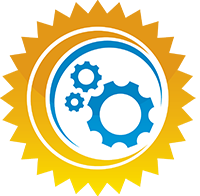Partners collaborate to create T3 success

Matt Bergan of Kotzebue Electric Association shows T3 students the newest solar array in Kotzebue.
August 25, 2023
When partners collaborate to create meaningful experiences for students to learn and make a difference in their communities, epic things can happen. As was the case with the 2023 Teaching Through Technology summer program.
Thirty-seven high school students from across Alaska participated in the six-week residential program. During the intensive weeks, the students learned about and addressed problems pertaining to various areas of science, including mariculture — the farming of marine organisms for food and other products in enclosed or open sections of the ocean — climate change impacts, earth science, and energy.
Ten of the students signed up for the energy strand of the program. ACEP worked with its partners to help those students understand the unique energy challenges facing remote communities, including those in the Northwest Arctic Borough.
Perhaps the best way to understand a problem is to see it firsthand. The students and staff spent nine days in Kotzebue and Noatak. They met with locals, community partners, and experts, to experience life and the challenges facing these communities — from extreme transportation challenges and energy costs, to changing permafrost and a limited workforce. The students learned how these factors impact the communities and how experts are developing solutions.
Matt Bergan, project manager for Kotzebue Electric Association, led students on a tour of the renewable energy farm while contractors were installing the latest batch of panels in the solar array.
“It is a dollar a pound,” Bergan explained, referring to the shipping cost of the solar panels being installed. “And on top of that, we can only get barges in for about two months a year, July and August.”
While in Noatak, students met with Paul Walton, manager of the water treatment plant, and Una Edwardson from Alaska Native Renewable Industries. Walton showed the students where the plant foundation was cracking due to the permafrost thawing beneath the building. “We have to run refrigerant through a loop of pipes underneath the building to prevent further permafrost loss!”
The thawing permafrost along the banks of the Noatak river has also caused the river to become both wider and shallower, drastically limiting barge transportation to the village. This means that diesel used for home heating and electricity generation has to be flown in, resulting in some of the highest energy costs in the U.S.
The students spent their final three weeks of the program at UAF, working with experts to develop and present possible solutions to the energy problems facing rural Alaska.
Tom Marsik from ACEP, the National Renewable Energy Laboratory, and the Cold Climate Housing Research Center worked with students on building construction and thermal efficiency. Ben Loeffler, a research professional at ACEP and Pacific Marine Energy Center co-director, talked about challenges facing hydrokinetic development in the Arctic. Concerning renewable energy generation, Rich Strömberg from ACEP’s solar research team shared the physics, practices, and ethics pertaining to photovoltaic technology.
It made a big impact on the students to learn about the history of Kotzebue and Noatak and reflect on the challenges that village residents face, then learn from ACEP researchers about efforts to seek solutions.
“What life is like for those that live [in Kotzebue and Noatak], and what problems they face…even though my life is very different from the people we talked to, I was still able to find some similarities that let me go, ‘Hey, I know what that feels like,’” said Marais Anderson, a T3 student from Fairbanks.

ACEP’s Rich Strömberg showcases the evolution of solar photovoltaic technology.
“So, to me, the most important thing I took away from our field week was a deeper understanding of the people we are trying to help and the problems they face.”
The 2023 T3 Summer Program was made possible with funding from the UAF Upward Bound Program; an Office of Naval Research initiative, the ARCTIC Program; the State of Alaska Career and Technical Education program; and with support from the Northwest Arctic Borough School District.
For more information about the UAF T3 program or T3 summer program, please contact
George Reising at gbskrabareising@alaska.edu.


